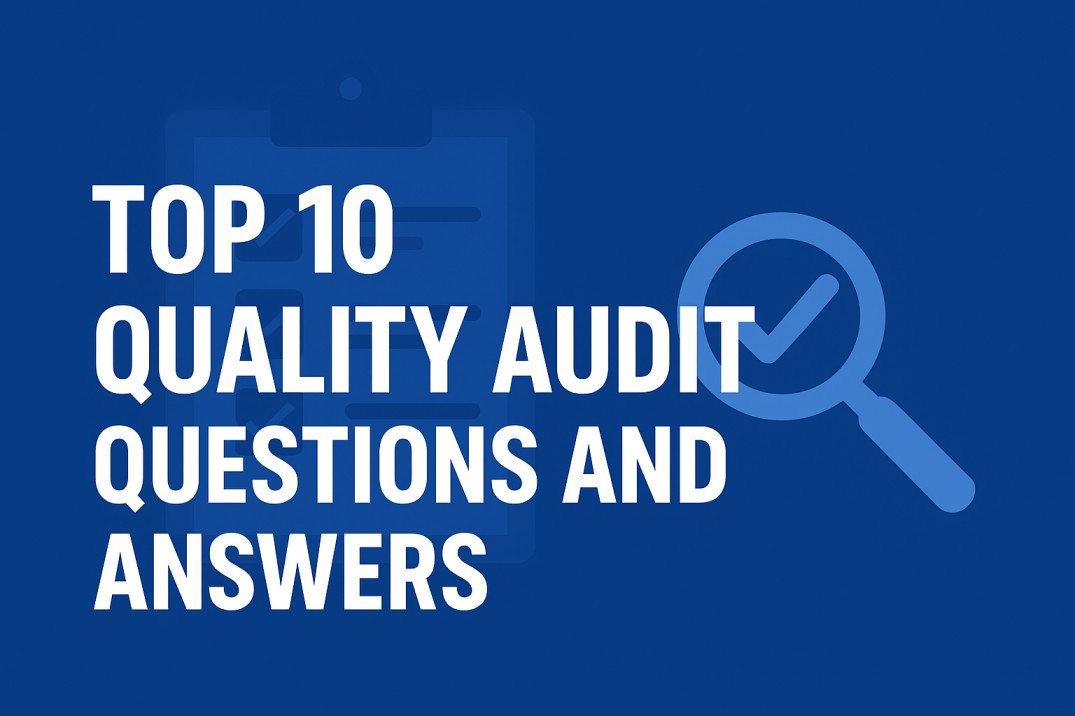Quality audits play a crucial role in ensuring that an organization’s processes, systems, and products meet defined standards. Whether it’s an ISO 9001 audit, IATF 16949 audit, or a Supplier quality audit, being prepared with the right answers can make a big difference.
In this detailed guide, we’ll explore the top 10 most common quality audit questions and answers — with explanations and practical examples to help you confidently face your next audit.
1. What is the Purpose of a Quality Audit?
Answer:
A quality audit is conducted to evaluate whether an organization’s processes comply with planned arrangements, QMS procedures, standards, and customer requirements.
The main objectives include:
- Checking process effectiveness and compliance
- Identifying areas for improvement
- Ensuring corrective actions are implemented
- Increasing customer satisfaction
Example:
During an ISO 9001 audit, the auditor may ask:
“How do you ensure your process meets customer requirements?”
You should demonstrate your documented procedures, inspection records, and customer feedback system.
2. What are the types of Quality Audits?
Answer:
Quality audits are categorized into three main types:
- Internal Audit (First Party): Conducted by internal teams to verify internal processes.
- Supplier Audit (Second Party): Conducted by a company on its suppliers.
- Certification Audit (Third Party): Performed by external certification bodies like ISO or IATF auditors.
Example:
An internal audit may focus on whether calibration and training records are maintained as per ISO 9001:2015 Clause 7.2.
3. What documents do Auditors commonly check?
Answer:
Auditors typically review key documents to verify compliance and traceability:
- Quality Policy and Objectives
- Standard Operating Procedures (SOPs)
- Calibration and Maintenance Records
- Internal Audit Reports and Corrective Actions
- Management Review Minutes (MRM)
- Customer Complaints and NC (Non-Conformance) Reports
Tip:
Keep your documented information organized by process, and ensure your latest revision is available.
4. How do you handle Non-Conformities found during Audit?
Answer:
Every organization should have a structured approach for handling non-conformities:
- Identify and record the non-conformity.
- Analyze the root cause using tools like 5 Whys or Fishbone Diagram.
- Implement corrective and preventive actions (CAPA).
- Verify the effectiveness of the action taken.
Example:
If the auditor finds an expired calibration certificate, you should record it, analyze why it was missed, and take corrective steps to ensure it is not missed again.
5. How is Employee competence verified?
Answer:
Employee competence is verified through:
- Training records
- Skill matrix
- On-job evaluations
- Certificates for critical tasks (e.g., welding, inspection)
Example Audit Question:
“How do you ensure that only trained personnel perform product inspections?”
Show training attendance records, qualification tests, or supervisor evaluations.
6. How do you ensure Product Traceability?
Answer:
Traceability ensures that every product or batch can be traced back to its raw materials, production processes, and inspection records.
You can demonstrate traceability through:
- Batch numbers and labels
- Barcode systems
- Inspection reports linked with production records
Example:
Auditors may ask you to trace a product from the final inspection to the raw material batch. Keep clear labeling and digital records to make this easy.
7. How is Customer Feedback managed?
Answer:
Customer feedback is a vital part of continual improvement. The process should include:
- Score Card Collection (via email, portal, or surveys)
- Analysis of satisfaction trends
- Actions on negative feedback
- Management review inputs
Example:
If you receive a complaint, show how it was recorded, investigated, and resolved with corrective action.
8. What Is the Role of Management Review in a Quality System?
Answer:
A Management Review Meeting (MRM) is held at planned intervals to evaluate the overall health of the quality management system.
Topics typically covered:
- Quality objectives and key performance indicators (KPI)
- Audit results
- Customer feedback
- Process performance
- Improvement opportunities
Example:
Auditors may ask for the latest management review minutes and action plans. Always record decisions and the responsible persons.
9. How do you ensure Supplier Quality?
Answer:
Supplier quality management includes:
- Supplier evaluation and approval process
- Periodic performance review (delivery, rejection, complaint)
- Incoming inspection results
- Supplier audits and feedback reports
Example:
Show your supplier evaluation form, vendor rating records, or improvement actions taken for poor-performing suppliers.
10. How do you promote Continuous Improvement?
Answer:
Continuous improvement is at the heart of every QMS. It can be demonstrated through:
- Kaizen activities
- 5S implementation
- Corrective & preventive actions
- Employee suggestions
- Data analysis from NCRs or audits
Example:
If you’ve reduced internal rejections by 20% using Kaizen or Poka Yoke, highlight that as evidence of improvement.
Bonus Tip: Prepare a Quality Audit Checklist
Before your next audit, prepare a checklist covering:
- Process objectives and KPIs
- Document availability
- Equipment calibration
- Non-conformance closure
- Training records
A structured checklist ( ISO 9001/IATF 16949 Audit Checklist) ensures nothing is missed during IATF audits.
Key Takeaways
✅ Be honest and confident during audits — auditors evaluate processes, not people.
✅ Keep records organized and traceable.
✅ Review past audit findings before every new audit.
✅ Engage your team in continuous improvement and root cause analysis.
✅ Use tools like FMEA, 5 Whys, Pareto Chart, and Control Charts to show data-driven quality control.
Conclusion
Facing an audit doesn’t have to be stressful. When your processes are well-documented and your team understands the system, audits become opportunities for improvement — not inspection days.
By preparing answers to these top 10 quality audit questions, your organization will not only pass audits confidently but also build a strong culture of continuous improvement and customer satisfaction.
📘 Read Next:
👉 VDA 6.3 Process Audit Explained – Key Requirements for Suppliers
👉 IATF 16949 Clauses and Requirements – Complete Guide 2025

